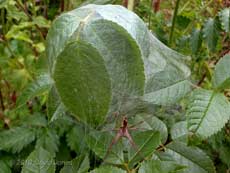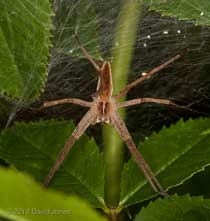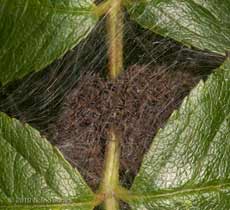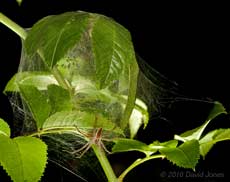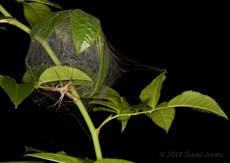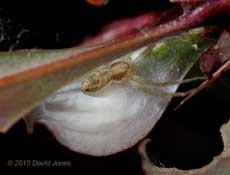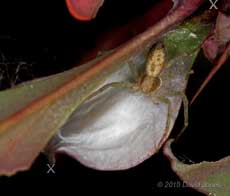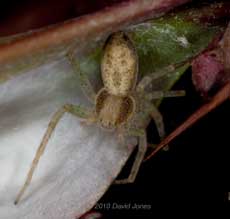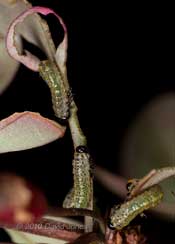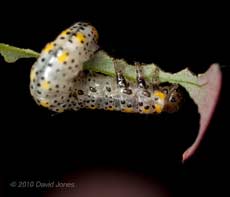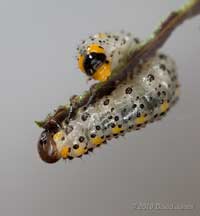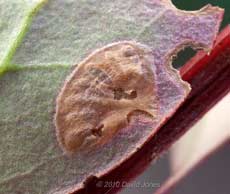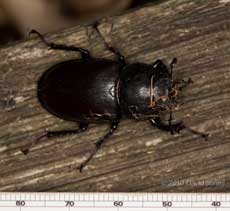Go to the last entry on this page .....Go to previous entry7 July - An attempt to get the diary going again! Since that wet second day down in Cornwall we have seen no more than a few drops of rain. We have had a lot of sunshine nearly every day, with daytime temperatures fluctuating from the low twenties to over 30C on several days. Despite the conditions, I have hardly picked up my cameras, and at the moment I'm having trouble keeping awake through the day. However, an accidental discovery two days ago needed to be recorded - I was using one of my long-handled plant pruners to trim the shrubs on the far side of the big pond. The pruner grips the cut stem, and this allows me to inspect each stem before discarding it. As I pruned it seemed that I wasn't going to find anything, until I snipped off a branch that extended up from the top of a rose bush. his had a large silk structure that enveloped some leaves to create an enclosed dome measuring some 6x6x8cm. There was a very agitated adult spider on the outside, and a large group of very small spiders in a tight clump inside the top of the dome. My pruning came to a premature end as I organised a suitable bottle to fill with water to ensure that the stem and leaves remained as undisturbed as possible.
It is now in residence on my veranda and my little grand-daughter thought it fantastic when she came to visit yesterday!
The spider is one that I have seen very rarely in the garden, and then only low down amongst plants next to the big pond. In fact my only entries about it were back in 2006. It is a hunting spider called Pisaura mirabilis, also known as the 'nursery web spider'. It is a common spider of low vegetation of grassland, heathland and woodland clearings. The species does not use webs to catch prey, and when the female first lays her eggs she produces an egg sac that she carries around with her. It is only when the eggs are close to hatching that she creates the structure that I very nearly destroyed,
and in this case the eggs had obviously recently hatched, although the density of silk used for the canopy mean that it may be difficult to make out the young spiders in this picture.
While they remain clustered together during the day, they spread out as dusk passes, and you can just make them out in this photograph while the adults continues to guard them. The top of the stem is in contact with other plants should the youngsters decide that it is time to leave
The darkness also made it possible to see the overall structure more clearly.
It seems that the species presents me with an interesting challenge for the future. Before mating the male catches some prey, wraps it in silk and presents it to the female to distract her while he mates with her.
8 July - A day that started overcast, and even a bit damp at times during the first part of the morning. However, that was a memory by noon and the afternoon was hot, with the temperature soon up in the upper twenties for a couple of hours. The nursery web is still in use, with no sign of the spiderlings leaving it tonight (as of 9.40pm).
In contrast to that large structure, today I've recorded another, much smaller female spider looking after her offspring. This time, the structure covers the underside of a single Burberis leaf, and the female spider spends much of her time spread across it in a defensive posture, despite having lost two hind legs.
Every-so-often she would move off the leaf without going away from it, and I think she was adding more silk. This activity gave me the chance to get a clearer picture of her. In this picture the distance between the two crosses is 15mm, giving the spider a body length of around 4mm.
A look through my spider guide suggests that it fits the description and behaviour of a female Philodromus dispar, although a definitive ID would probably need a microscopic examination. P. dispar is common in southern UK where it lives on low vegetation, bushes and low tree branches where it lays eggs in a 'wooly or gauze-like exterior'. The female stands over the egg case to guard it.
I found the spider while investigating what was eating leaves on our Burberis shrub. The plant has been in the garden since we moved in in 1975 and this is the first year that I have seen damage like this on the plant.
It turned out to be a sawfly, or rather numerous sawfly larvae. These were just 5mm or so long, but I also found a couple larger examples. While they looked very similar to the sawfly larvae that I sometimes see on our Birch tree, while those erect their tail ends when disturbed, these larvae do not.
This one was more than 15mm long, and was feeding on the remnants of a leaf when I first spotted it.
Within a short time there was nothing more than the central vein of the leaf left. While it doesn't appear in my insect guides, a quick search of the web soon came up with an ID. It is the Berberis Sawfly (Arge berberidis), a European species that was first found in the UK in 2002, and is spreading quickly across the country.
The Royal Horticultural Society (RHS) has an interesting page about it, including a survey as they track its spread.
The article states that the female adult lays eggs under the surface of a leaf, in batches of up to seven. On the undersides of several leaves I found fan-like structures similar to this one. I suspect that this marks where such a batch of eggs hatched into larvae .
10 July - The present heat wave continues - another dry couple of days with the daytime temperature in the garden reaching 30C.
It is now in temporary custody until tomorrow so that my grand-daughter can have a chance to see it tomorrow. Earlier today, and in her home, she pointed out to me a Small Magpie moth, and it was a real delight to see her face when I persuaded it to land on my hand so that she could take a close look - a 'waw' moment for her, and me!
Tonight at just before 11pm a hedgehog is making its nightly visit. At dusk I soaked a small area of ground under the bird feeders to encourage a few worms to the surface, and if that fails, it seems to enjoy sunflower kernels! No further entries until September (link below).
Click on images to see larger version |
|
